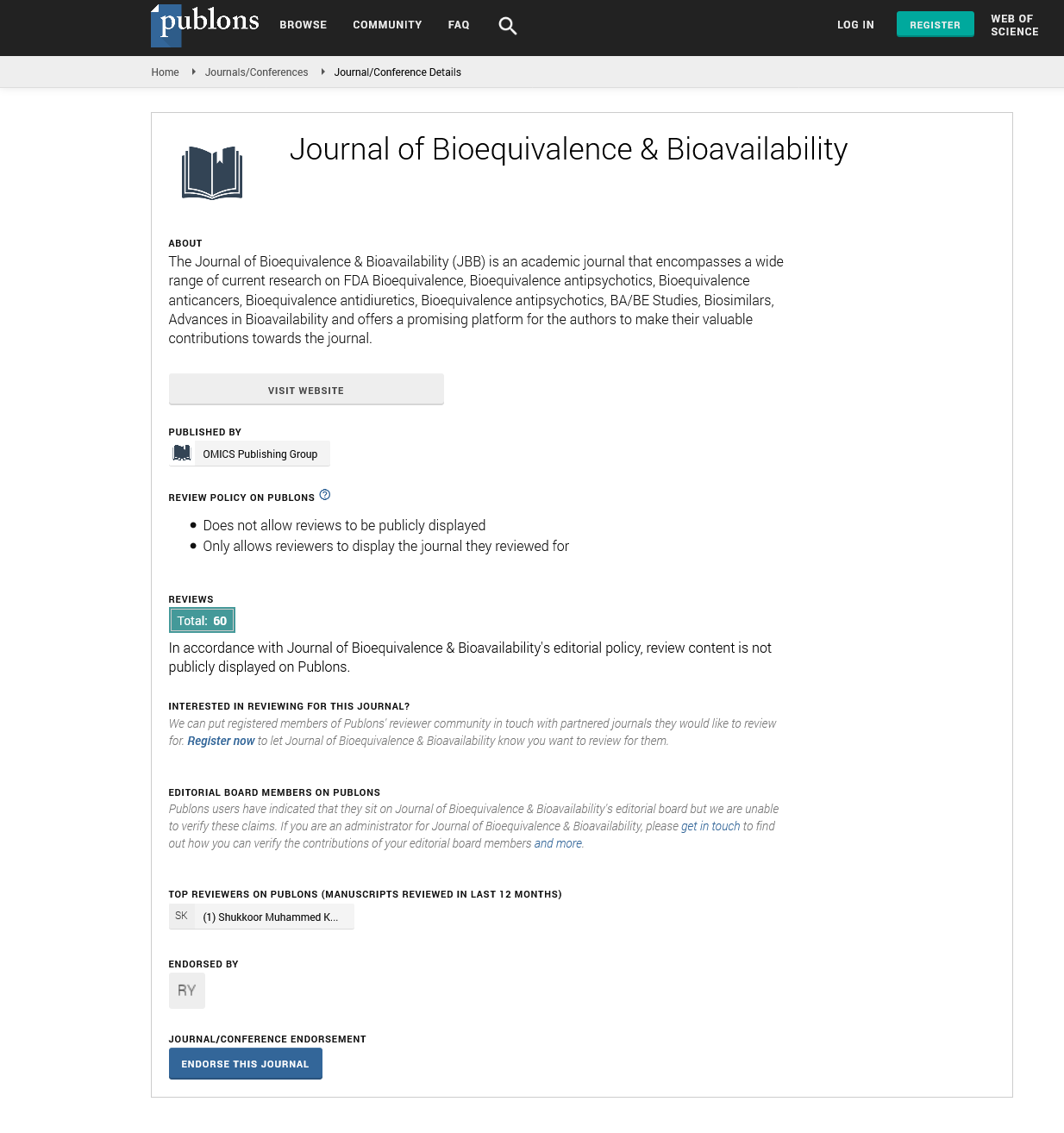PMC/PubMed Indexed Articles
Indexed In
- Academic Journals Database
- Open J Gate
- Genamics JournalSeek
- Academic Keys
- JournalTOCs
- China National Knowledge Infrastructure (CNKI)
- CiteFactor
- Scimago
- Ulrich's Periodicals Directory
- Electronic Journals Library
- RefSeek
- Hamdard University
- EBSCO A-Z
- OCLC- WorldCat
- SWB online catalog
- Virtual Library of Biology (vifabio)
- Publons
- MIAR
- University Grants Commission
- Geneva Foundation for Medical Education and Research
- Euro Pub
- Google Scholar
Useful Links
Share This Page
Journal Flyer

Open Access Journals
- Agri and Aquaculture
- Biochemistry
- Bioinformatics & Systems Biology
- Business & Management
- Chemistry
- Clinical Sciences
- Engineering
- Food & Nutrition
- General Science
- Genetics & Molecular Biology
- Immunology & Microbiology
- Medical Sciences
- Neuroscience & Psychology
- Nursing & Health Care
- Pharmaceutical Sciences
Commentary - (2022) Volume 14, Issue 1
A Short Note on Bioequivalence Antidiabetics
Daniel Frostier*Received: 04-Jan-2022, Manuscript No. JBB-22-451; Editor assigned: 06-Jan-2022, Pre QC No. JBB-22-451 (PQ); Reviewed: 18-Jan-2022, QC No. JBB-22-451; Revised: 21-Jan-2022, Manuscript No. JBB-22-451 (R); Published: 27-Jan-2022, DOI: 10.35248/0975-0851.22.14.451
About the Study
Anti-diabetes drugs are a kind of drugs that lower abnormally high levels of glucose in the blood, a characteristic of endocrine disorders known as diabetes mellitus. Anti-diabetes drugs are medicines designed to stabilize and control blood sugar levels in diabetics. Anti-diabetes drugs are often used to treat diabetes. There are various types of anti-diabetes drugs such as insulin, pramlintide (amylin), GLP1 receptor agonists (such as Vietta and Victorosa), and oral hypoglycemic agents (tablets). Type I diabetes is a condition in which the body does not produce insulin. Therefore, insulin is the only treatment effective for type 1 diabetes. Injected insulin acts just like naturally occurring insulin to lower blood glucose levels. Type 2 diabetes initially has insulin resistance, this happens when the cells of the body do not respond to insulin in the same way as people without diabetes. Oral antidiabetic agents work in various ways to reduce blood sugar levels in people with type 2 diabetes, some stimulate insulin secretion by the pancreas, and others improve the responsiveness of cells to insulin or prevent glucose production by the liver. Others slow the absorption of glucose after meals. Many people with type 2 diabetes ultimately need insulin to control their high blood sugar levels. Each class of medicine has one or more medicines. Some of these drugs are taken orally, while others require injections. Drugs included older standbys such as metformin and insulin, and sulfonylurea drugs such as glipizide (glucotrol) and glimepiride (amalyl). Other studies have considered newer and more expensive classes, including thiazolidinediones such as pioglitazone (Actos) and rosiglitazone (Avandia). DPP inhibitors such as sitagliptin (Januvia) and saxagliptin (Onglyza). Many studies tested only a single drug, but more than 100 studies used the drug in combination with metformin. Overall, it is found that metformin worked as well as or better than other drugs in lowering blood sugar levels. When it comes to preventing complications and prolonging people's lifespan, a single drug or drugs combination was unnoticeable.
Diabetes is a complex chronic disease associated with hyperglycemia or a hyperglycemic condition caused by a deficiency of insulin secretion, action, or both. Chronic metabolic imbalances associated with this disease increase the risk of long-term macro vascular and micro vascular complications in patients and, if not managed with quality care, the risk of Cardiovascular Disease (CVD). Causes frequent hospitalizations and complications, including increased. Type 2 diabetes mellitus is a common and increasingly prevalent disease and is thus a major public health concern worldwide. Common antidiabetic agents include:
• Alphaglucosidase inhibitors (acarbose, miglitol).
• Amylin analogs (pramlintide).
• Dipeptidyl peptidase 4 inhibitors (alogliptan, linagliptan, saxagliptin, sitagliptin).
• Incretin mimetics (albiglutide, dulaglutide, exenatide, liraglutide, lixisenatide).
• Insulin.
• Meglitinides (nateglinide, repaglinide).
• Nonsulfonylureas (metformin).
• SGLT2 inhibitors (canagliflozin, dapagliflozin, empagliflozin).
• Sulfonylureas (chlorpropamide, glimepiride, glipizide, glyburide, tolazamide, tolbutamide) and thiazolidinediones (rosiglitazone, pioglitazone).
People with type 1 diabetes, daily insulin injections are essential to maintain health. Type 1 diabetics must also eat properly, keep blood glucose levels from going too low or too high, and monitor blood sugar levels. People with type 2 diabetes, diet and exercise may be enough to control blood glucose levels in some. However, when diet and exercise is no longer efficient, antidiabetic drugs may be prescribed. Medication will either be taken orally in the form of tablets (oral hypoglycemics), or be injected (insulin and GLP1 receptor agonists). Metformin are commonly prescribed as a first antidiabetic medication. If biguanides are not effective on their own you may be given alternative medication either instead of, or in addition to,biguanides. The types of medication you are offered could depend on a variety of factors as different medication have different advantages and disadvantages. Anti-diabetics are not intended to treat diabetes, but they can help diabetics manage their condition and reduce the risk of diabetic complications. People with diabetes may need to take anti-diabetic drugs for life to control their blood sugar levels and avoid hypoglycemia and hyperglycemia. There are several classes of type 2 diabetes medications. Each class of medicine works in different ways to lower blood sugar levels. The drug works in the following ways:
• The pancreas is stimulated to produce and release more insulin.
• Inhibits the production and release of glucose from the liver.
• Blocks the action of stomach enzymes that break down carbohydrates.
• Improves cell sensitivity to insulin.
Inhibition of glucose reabsorption in the kidney.
Slows the speed at which food moves through the stomach.
Citation: Frostier D (2022) A Short Note on Bioequivalence Antidiabetics. J Bioequiv Availab. 14:451
Copyright: © 2022 Frostier D. This is an open-access article distributed under the terms of the Creative Commons Attribution License, which permits unrestricted use, distribution, and reproduction in any medium, provided the original author and source are credited.

